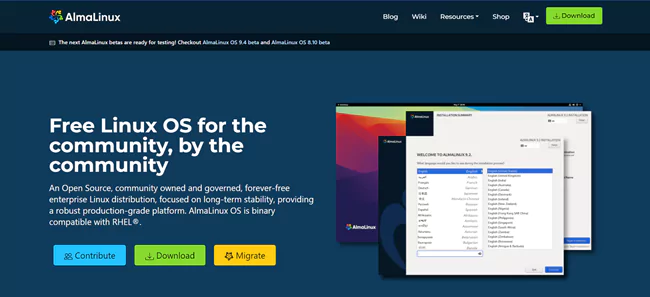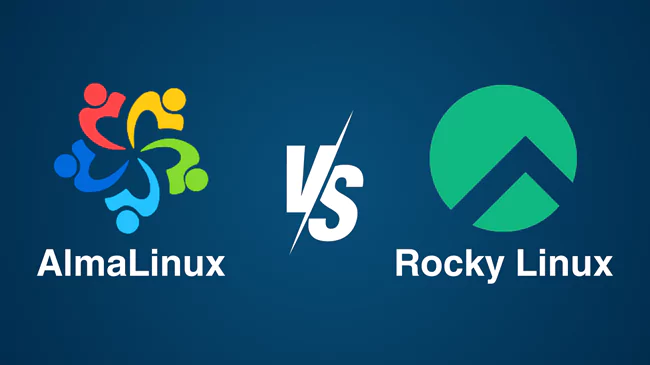The variety of server operating systems, particularly open-source varieties, is quite large. Among these differences, Red Hat, Debian, and CentOS are the most widely used. These operating systems are quite old but remain functional and extremely popular online.
Red Hat’s decision to replace CentOS with CentOS Stream has disappointed businesses that rely on Linux as a server operating system.
CentOS Stream is a continuous-release operating system, which means it lacks dependability because there is no definite update release schedule. However, immediately after Red Hat announced the end of CentOS, two similar distributions, Rocky Linux and AlmaLinux, were introduced. These two distributions remain popular among CentOS users.
These two open-source, community-driven challengers are the best CentOS alternatives, each providing a dependable enterprise solution. AlmaLinux and Rocky Linux emerged in 2021. These distributions have a 1:1 compatibility with Red Hat Enterprise Linux. This brings about the Alma Linux vs Rocky Linux a popular topic among developers and system administrators alike.
AlmaLinux got initial development and support from CloudLinux with a $1 million annual development fund but does not own or control AlmaLinux, it soon gained appeal because of its powerful security features. CIQ supported Rocky Linux, which secured $26 million in funding. They chose to implement SELinux to ensure strict access control. Although equal in performance and stability, two CentOS alternatives differ slightly in terms of safety features and user scale—AlmaLinux, which has significant partners like as Microsoft and AWS, and Rocky Linux, which has support from industry titans such as Google and VMware.
What is AlmaLinux?

The open-source RHEL variant of CloudLinux, AlmaLinux, was released in 2021. The plan is to develop a specialized Linux-based platform for data centers and hosting companies. Although the OS was first made available as Project Lenix, most users now refer to it as AlmaLinux.
Though it is the most important contributor to the AlmaLinux development cycle, which is CloudLinux is one of its supporters rather than its owner. The AlmaLinux OS base is, in fact, separate from CloudLinux. Furthermore, you might be surprised to learn that there is absolutely nothing in common between CloudLinux OS and AlmaLinux.
Because AlmaLinux integrates the CIS Benchmark, it has an advantage in terms of security. These are recommended procedures for protecting data and IT systems from online threats. In addition to providing a ten-year maintenance lifetime, AlmaLinux also includes tools such as CIS-CAT to assist you in detecting and resolving possible security vulnerabilities, therefore providing an additional level of assurance regarding the integrity of your system. Additionally, AlmaLinux provides you with updates through:
- OpenSCAP and Errata for prompt security advisories.
- OVAL definitions to look for vulnerabilities.
- With security mailing lists, you can be sure you’re always up to date on the most recent security fixes and updates.
Features of AlmaLinux:
AlmaLinux, which was established with assistance from the CloudLinux OS group, guarantees that it is compatible with an effort to closely resemble RHEL. A substantial yearly sponsorship of $1 million, including funds donated by CloudLinux and other sponsoring organizations, supports its development. Among its notable characteristics are:
- 1:1 binary compatibility guarantees smooth migrations and strong integrations with RHEL.
- A dedication to system security that includes hardened system configurations based on the CIS Benchmark.
- Long-term stability for your business is ensured by an 8-year support horizon and a forward-looking 10-year lifetime.
What is Rocky Linux?

Rocky Linux is an additional enterprise-class, open-source operating system that uses the same source code as Red Hat Enterprise Linux. Since its debut in 2021, the first stable version has been developed by the community.
CentOS inventor Gregory Kurtzer intended for Rocky Linux to serve as an operating system having goals comparable to those of CentOS. With RHEL, the distribution is still binary compatible, but it is older.
However, Rocky Linux solidifies its position as a safe substitute for CentOS by utilizing SELinux (Security-Enhanced Linux), an NSA-developed Mandatory Access Control mechanism. With SELinux as a fundamental component of its ecosystem, Rocky Linux is built to offer your organization the granular control over security rules that it requires. Not to be surpassed in terms of assistance, Rocky Linux introduces a dedication to stability over the long term by providing:
- Protocols for Network Time Security to make NTP operations safer.
- Long-term support that is consistent for their versions and bug upgrades to guarantee continuous system security and optimization.
Features of Rocky Linux:
This takes us to Rocky Linux, which is led by CentOS inventor Gregory Kurtzer. There is a noticeable emphasis on precise compatibility with RHEL. Rocky Linux markets itself as a reliable option for enterprise users, having secured a substantial $26 million investment from CIQ. Its salient characteristics are as follows:
- Complete compatibility, bug-for-bug, with RHEL guarantees consistent operation of your systems.
- Use of the Network Time Security (NTS) protocol inside NTP, enhancing your servers’ timing security.
- Support for Secure Boot provides improved defense against various security risks while the machine is booting up.
Check out the step-by-step instructions to download and install Rocky Linux on your computer.
AlmaLinux vs Rocky Linux: Which One to Choose?
AlmaLinux and Rocky Linux are two new distributions that have quickly garnered popularity. They are both driven by the community’s open-source projects that seek to offer a stable, secure, and dependable option to other distributions of Linux, particularly in enterprise settings.
AlmaLinux is built on the source of the successful Red Hat Enterprise Linux (RHEL) version and includes commercial support from Red Hat. This makes AlmaLinux an attractive option for enterprises that require an accepted version of Linux and are comfortable with the RHEL system.
However, Rocky Linux is designed to offer a more transparent and open option to other commercial Linux distributions. It is built on the source of the discontinued CentOS Linux. Along with being compatible with RHEL, its goals include offering a dependable and stable substitute for CentOS.
| Feature | AlmaLinux | Rocky Linux |
|---|---|---|
| Origin | Based on Red Hat Enterprise Linux (RHEL) source code | Based on Red Hat Enterprise Linux (RHEL) source code |
| Community Support | Backed by CloudLinux and other sponsors | Initiated by Gregory Kurtzer, supported by CIQ |
| Compatibility | 1:1 binary compatibility with RHEL | 1:1 binary compatibility with RHEL |
| Security | Hardened system configurations based on CIS Benchmark | Utilizes SELinux (Security-Enhanced Linux) |
| Long-term Support | 8-year support horizon, 10-year lifetime | Long-term support with consistent version updates |
| Stability | Stable releases with traditional release cycles | Stable releases with rolling release model |
| Enterprise Support | Commercially supported, TuxCare offers paid support | Supported by CIQ, financial backing from CIQ |
| Industry Partners | AMD, Microsoft, AWS, Equinix, and others | Financial support from CIQ, industry partnerships |
| Architecture Support | aarch64, ppc64le, s390x, x86_64 | aarch64, ppc64le, s390x, x86_64 |
Supporting Architecture:
AlmaLinux and Rocky Linux are RHEL forks that are 1:1 binary compatible based on the RHEL source code. The aarch64, ppc64le, s390x, and x86_ 64 architectures are supported.
Support for s390x was introduced in the latest version of AlmaLinux, while support for aarch64 was added in version 8.4.
Rocky Linux, in contrast with AlmaLinux, has always had support for aarch64. Version 9.x also included support for S390x and PPC64le.
RHEL-Rebuilding Skills:
In the discussion between AlmaLinux vs Rocky Linux, it’s also critical to consider each team’s experience in reintegrating RHEL into its distributions.
The Rocky Linux crew is quite knowledgeable in this area. However, the AlmaLinux team has great familiarity with CentOS as well, given their history of working on CloudLinux. Because of this, the primary team of developers of CloudLinux has been rebuilding RHEL for more than ten years.
This knowledge is useful when the team chooses which packages and services to add to the next version of their operating system after analyzing the current RHEL release.
Performance:
The most recent versions of AlmaLinux and Rocky Linux, which are based on the upstream kernel version 5.14, provide improved SELinux performance as well as other security improvements such as user authentication logs. As a result, there are essential variables that influence how efficient a Linux distribution is, such as security features or compatibility with frequently used applications and web/dedicated server components.
Since both of these operating systems are essentially the same RHEL rebuilds, it is evident that there is very little room for discussion between them. Thus, identifying variances in performance can be difficult. According to our experience, support for specific packages and libraries accounts for the majority of observed performance variances.
Dependability:
Regarding stability and dependability, both operating systems have a big advantage over CentOS. The upgrades and how Rocky Linux and AlmaLinux embraced them offer a strong basis for understanding this idea.
The process starts with CentOS rolling release updates. The upgrade is released to the subsequent RHEL release whenever problems are resolved. These will also be part of the soon-to-be-released Rocky Linux and AlmaLinux.
Its lack of some of the newest features is one effect of its stability. There are situations where new options for stable versions of these two operating systems are not released for several months after they are initially made available elsewhere.
AlmaLinux vs Rocky Linux, on the one hand, avoided potentially dangerous software installations while delaying the release of upgrades.
Packages included in the release are guaranteed to be quality-tested and prepared for use in production by use of this multi-phase approach. However, for people who need reliability, CentOS and AlmaLinux perform incredibly well.
Support:
Even if it is fully compatible with RHEL, many enterprise products might not work with AlmaLinux and Rocky Linux; this is usually because of underlying library incompatibilities or a lack of certification. Although organizations must certify their programs, according to Rocky Linux and AlmaLinux developers, more enterprise companies have made their apps available on Rocky and AlmaLinux due to increased client demand and their limits.
Safety:
In the Rocky Linux vs. AlmaLinux argument, security is a crucial consideration when it comes to safety. Because they are based on RHEL, both versions are safe. With the integrated Center for Internet Security (CIS) Benchmark, AlmaLinux users can customize the security of their system. A tool called CIS-CAT is offered by CIS, and it produces comprehensive data on possible security vulnerabilities. It also comes with the OpenSCAP program, which checks systems for vulnerabilities automatically and can be accessed using the OpenSCAP Workbench interface or the console.
Rocky Linux is now compatible with SELinux (Security Enhanced Linux), a new security method; the National Security Agency (NSA) created the MAC (Mandatory Access Control) architecture to fortify SELinux.
Corporate Support:
CloudLinux, the founders of AlmaLinux, are the project’s biggest supporters, providing approximately $1 million per year for its maintenance and development. Furthermore, it has received funding from 21 other sponsors and partners, while TuxCare provides paid support to its users. AlmaLinux has received significant support from AMD, Microsoft, Amazon Web Services, and Equinix, among others.
Kurtzer founded CIQ, which provided the starting money for Rocky Linux. In addition to financial support, CIQ continues to produce revenue for these initiatives.
Conclusion
In conclusion, Rocky Linux and AlmaLinux are community-driven CentOS alternatives with minor technological variations but similar goals; both are based on RHEL source codes. While AlmaLinux is commercially supported with traditional releases that focus on binary compatibility maintenance, Rocky Linux places a high value on community participation through rolling releases, so the choice between the two is based on specific needs as well as preferred support structures with desired levels of community involvement.
Finally, the choice between Rocky Linux vs AlmaLinux is based on individual requirements, preferences, and the desired level of community involvement. Rocky Linux follows a rolling release model and stresses community-driven development, whereas AlmaLinux offers long-term support and is backed by a commercial company.


